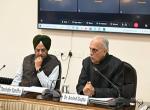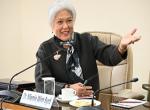Dr. Shashi Bala, Dean, Centre of Indology, Bharatiya Vidya Bhavan, gave a talk on ‘Indian Scholars in China: Voyages for Cultural Advancement’ at the Vivekananda International Foundation (VIF) on 13 Aug 2018. This was the second in a lecture series on India-China Cultural Linkages slated to be held at the VIF at regular intervals. Dr. Bala spoke on Indian monks and scholars who travelled to China and spread the message of Buddhism and other aspects of Indian culture.
The speaker started by noting that in our universities, topics such as India’s contribution to the world is rarely taught, hence many people are unaware about the cultural linkages different parts of the world had with India. The gist of her talk are as enumerated in succeeding parapraphs.
Many Buddhist scholar-monks from India visited China and helped in the propagation of Indian ideas and translation of Buddhist texts from Sanskrit to Chinese. Chinese emperors offered prestigious positions to Indian scholars in their court. They sent emissaries to collect texts from India. It is well-known that Asoka also sent Buddhist missions to different places.
These monks travelled mainly by the northern Silk Route. In the countries that dot this route, Sanskrit texts were translated into many languages. Kashgar was in fact a centre of Vedic learning. The Kushanas are an important link in the story of India-China cultural relations. They were one of the branches of the Yue-chi tribes, who ruled parts of Central Asia. They were the first to tell Chinese emperors about India. Khotan, an important centre of learning, was a halting place for monks and travelers. The Kushanas also ruled Kashgar and controlled Khotan and Yarkand. During their rule, there was a direct route from Gandhara. They also used the Brahmi script. This explains the discovery of many Brahmi manuscripts in China. I-Tsing has written that beyond the Great Wall of China, there was nothing Chinese, it was all Indian.
Before Buddhism reached China, the Chinese were building tombs. All the glory and splendor that is seen today in the architecture of China is a gift of Buddhism. Chinese unity itself is a gift of Buddhism. One day, the Han Emperor saw a dream that a light was entering his palace. Interpreters interpreted this dream as Buddhism was coming to China. The first Indian texts, however, that were translated into Chinese were not philosophical, but were simple texts, stories, moral teachings, parables etc. Later on, with the coming of various monks, deep philosophical texts also arrived in China and were translated.
A few among these scholar-travelers were: the Kushan monk Lokakshema who was an important translator; An Shih-kao, a Persian prince who became a monk and a scholar, the first to found a school of translation from Sanskrit texts into Chinese; Dharmagupta, monk from southern India who travelled to China and Central Asia; Vairochana, Kashmiri monk, went to Khotan, advised the king there to build a monastery; Buddhayashas, another Buddhist monk; Sanghadeva, another monk who went from Kashmir; Buddhashila, a monk expert in different subjects, he introduced logic, which was new for the Chinese, and was appointed as Rajguru; Gunavarman, famous for healing and who also went to Indonesia; Bodhidharma, originally a prince who promoted dhyanayoga known as Chan Buddhism; and of course, the famous Kumarajiva, son of a Kashmiri scholar and the princess of Kucha, he was taken as war booty to China and later made the Rajguru.
Before Kumarajiva, a literal translation procedure was followed. Kumarajiva did not do literal translation, he created the texts afresh in Chinese language; that is why the texts are so vibrant and relatively easy to follow. Many of these scholars also took with them other kinds of knowledge systems to China. For example, the Shaolin Monastery owes a debt to Indian influence in their martial arts.
Dr. Bala related many stories associated with these traveler monks, who not only instructed in Buddhism, but also performed many rituals and ceremonies in China.








Post new comment